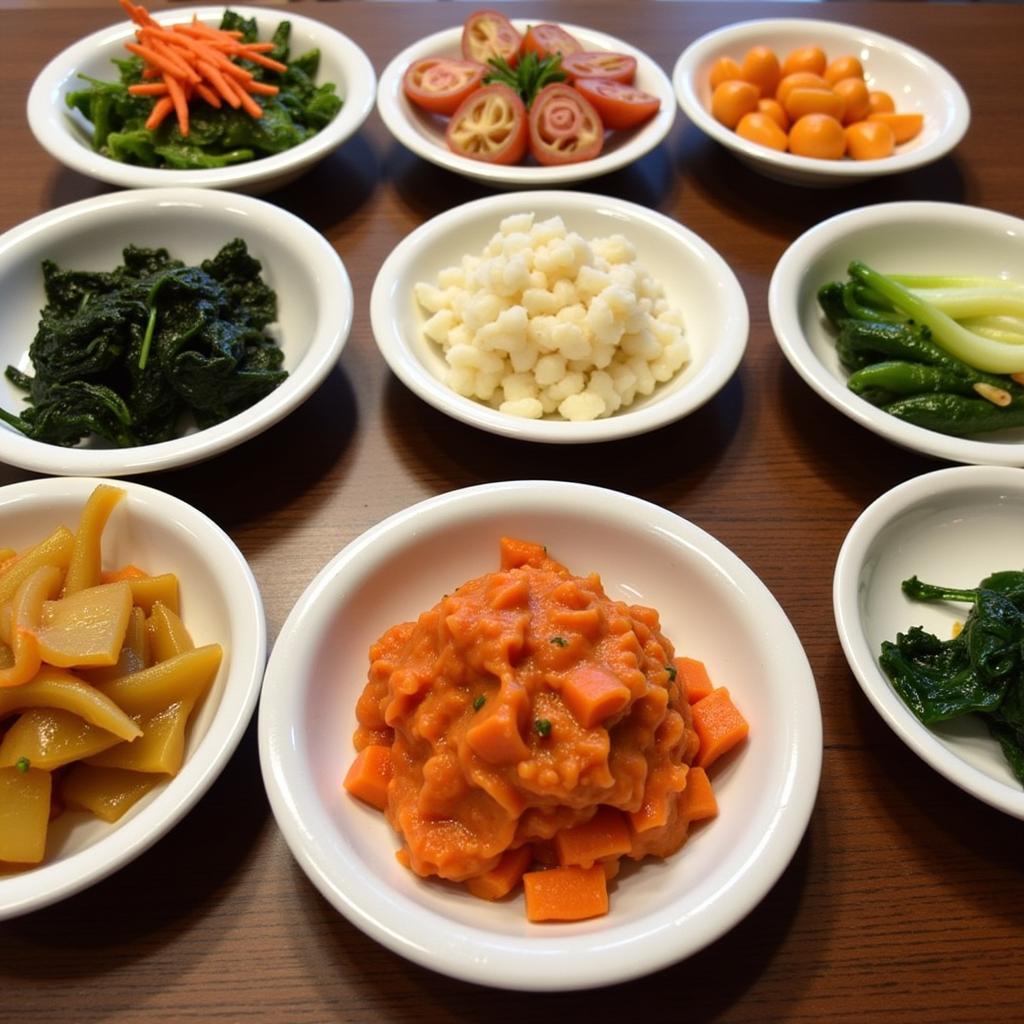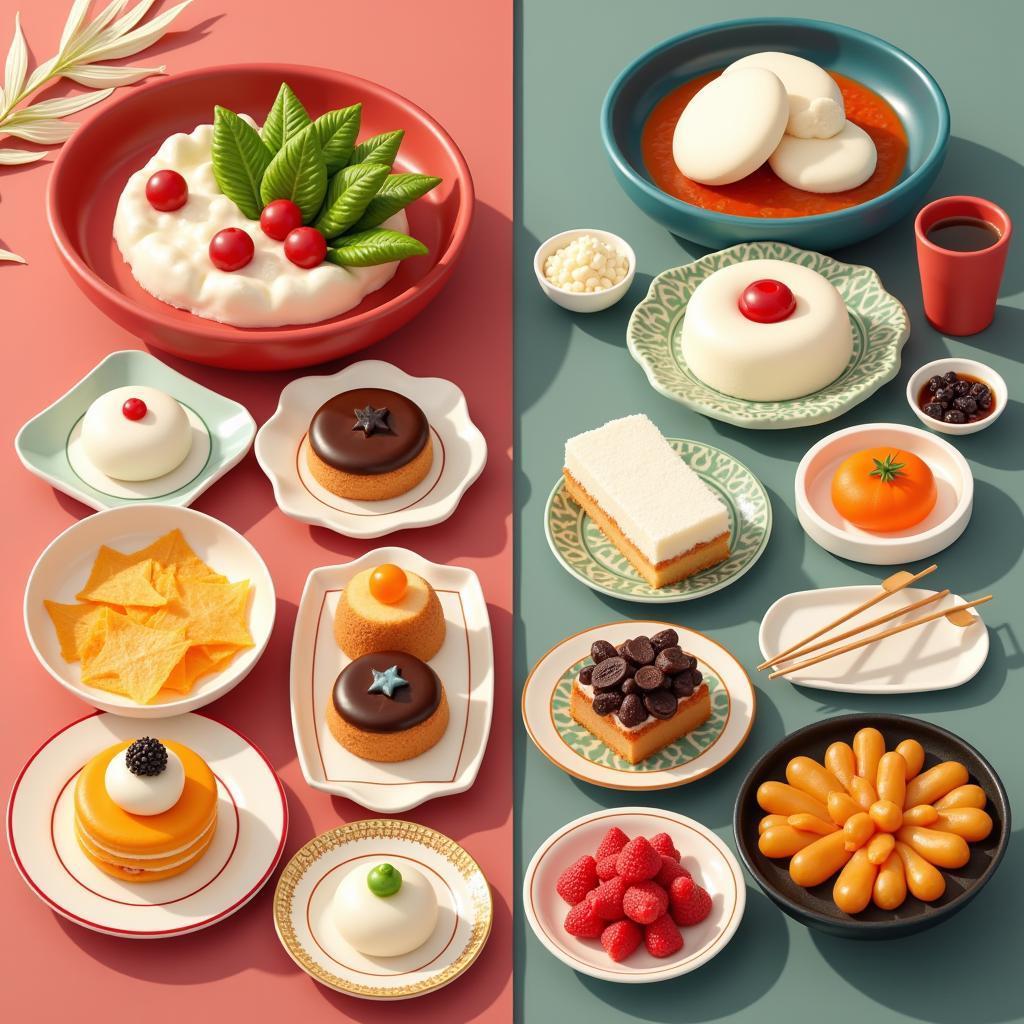The world of East Asian cuisine is a treasure trove of flavor, with Japanese and Korean food standing out as two of the most popular culinary experiences. But what are the key differences between these seemingly similar cuisines? While both share some common ingredients and culinary philosophies, exploring the distinct characteristics of Japanese Vs Korean Food reveals a world of unique tastes and traditions.
 A Vibrant Platter of Japanese and Korean Dishes
A Vibrant Platter of Japanese and Korean Dishes
A Matter of Philosophy: Subtlety vs Boldness
One of the most fundamental differences lies in the culinary philosophies that underpin each cuisine. Japanese food is often characterized by its emphasis on simplicity, purity, and seasonality. Ingredients are celebrated for their natural flavors, and dishes are meticulously crafted to highlight their essence. Wabi-sabi, the Japanese aesthetic centered around appreciating the beauty of imperfection and impermanence, is reflected in the elegant presentation of Japanese dishes.
Korean food, on the other hand, embraces bold flavors and vibrant colors. The cuisine is known for its generous use of garlic, chili peppers, and fermented ingredients, resulting in dishes that pack a punch. Korean cuisine also prioritizes banchan, a selection of small side dishes meant to complement the main course and create a harmonious balance of flavors and textures.
Staple Ingredients: Rice is King, But the Court Differs
Both cuisines rely heavily on rice as a staple ingredient, but the way it is prepared and consumed varies. In Japan, short-grain rice is favored for its sticky texture, ideal for sushi and onigiri. Korean cuisine typically uses medium-grain rice, often cooked with other grains like barley or millet for added flavor and nutrition.
 An Array of Korean Banchan Side Dishes
An Array of Korean Banchan Side Dishes
Beyond rice, Japanese cuisine features a prominent use of seafood, from delicate sashimi to hearty ramen broths. Soy sauce, mirin, and sake are essential seasonings that add umami and depth of flavor. Korean food, while also utilizing seafood, incorporates more meat, particularly beef and pork, in dishes like bulgogi and Korean BBQ. Gochujang (red chili paste) and doenjang (fermented soybean paste) are cornerstone ingredients that lend a spicy and savory character to Korean dishes.
Culinary Experiences: A World of Contrast
When it comes to dining experiences, both Japanese and Korean cuisines offer unique traditions. Japanese cuisine emphasizes visual appeal and ceremonial presentation. The art of plating is taken seriously, with dishes often resembling miniature works of art. Meals are typically served in courses, allowing diners to savor each element individually.
Korean cuisine, on the other hand, is known for its communal dining style. Dishes like Korean BBQ are often cooked and shared at the table, fostering a sense of togetherness and conviviality. Korean meals are also characterized by the abundance of banchan, encouraging diners to sample a wide variety of flavors.
Beyond the Plate: Cultural Significance of Food
Understanding the differences between Japanese and Korean food goes beyond mere ingredients and cooking techniques. Both cuisines are deeply intertwined with their respective cultures and histories. Japanese food reflects the country’s appreciation for minimalism, seasonality, and harmony with nature. Korean food, on the other hand, embodies the Korean spirit of resilience, resourcefulness, and a love for bold flavors.
Conclusion: A Culinary Adventure Awaits
The Japanese vs Korean food debate is not about declaring a winner, but rather celebrating the unique qualities of each cuisine. Both offer a world of flavors and culinary experiences waiting to be discovered. Whether you prefer the subtle elegance of Japanese cuisine or the fiery complexity of Korean food, one thing is for sure: your taste buds are in for a delicious adventure.
FAQs about Japanese vs. Korean Food
1. Is Japanese food always raw?
No, while Japanese cuisine is known for raw dishes like sushi and sashimi, it also includes a vast array of cooked dishes such as ramen, tempura, and teriyaki.
2. Is Korean food very spicy?
Korean food can be spicy, but the level of spice can vary greatly. While dishes like kimchi jjigae are known for their fiery kick, many other Korean dishes offer milder flavor profiles.
3. What are some popular Japanese and Korean drinks?
Popular Japanese drinks include sake (rice wine), green tea, and shochu (distilled beverage). In Korea, soju (a clear distilled spirit), makgeolli (unfiltered rice wine), and barley tea are widely enjoyed.
4. Are there vegetarian options in Japanese and Korean cuisine?
Yes, both Japanese and Korean cuisines offer a variety of vegetarian options. Look for dishes featuring tofu, vegetables, noodles, and rice.
5. What is the dining etiquette like in Japan and Korea?
Both countries have specific dining customs. In Japan, it’s considered polite to use chopsticks properly and avoid sticking them upright in your rice bowl. In Korea, it’s customary to wait for the eldest person at the table to start eating first.
 A Selection of Japanese and Korean Desserts
A Selection of Japanese and Korean Desserts
Still curious about the nuances of Japanese and Korean food?
Explore our other articles comparing specific dishes and regional variations within these fascinating culinary traditions.
For personalized recommendations and expert advice on your next culinary adventure, don’t hesitate to reach out to our team. Contact us at 02437655121, email us at [email protected] or visit us at 3PGH+8R9, ĐT70A, thôn Trung, Bắc Từ Liêm, Hà Nội, Việt Nam. Our dedicated customer service team is available 24/7 to assist you.